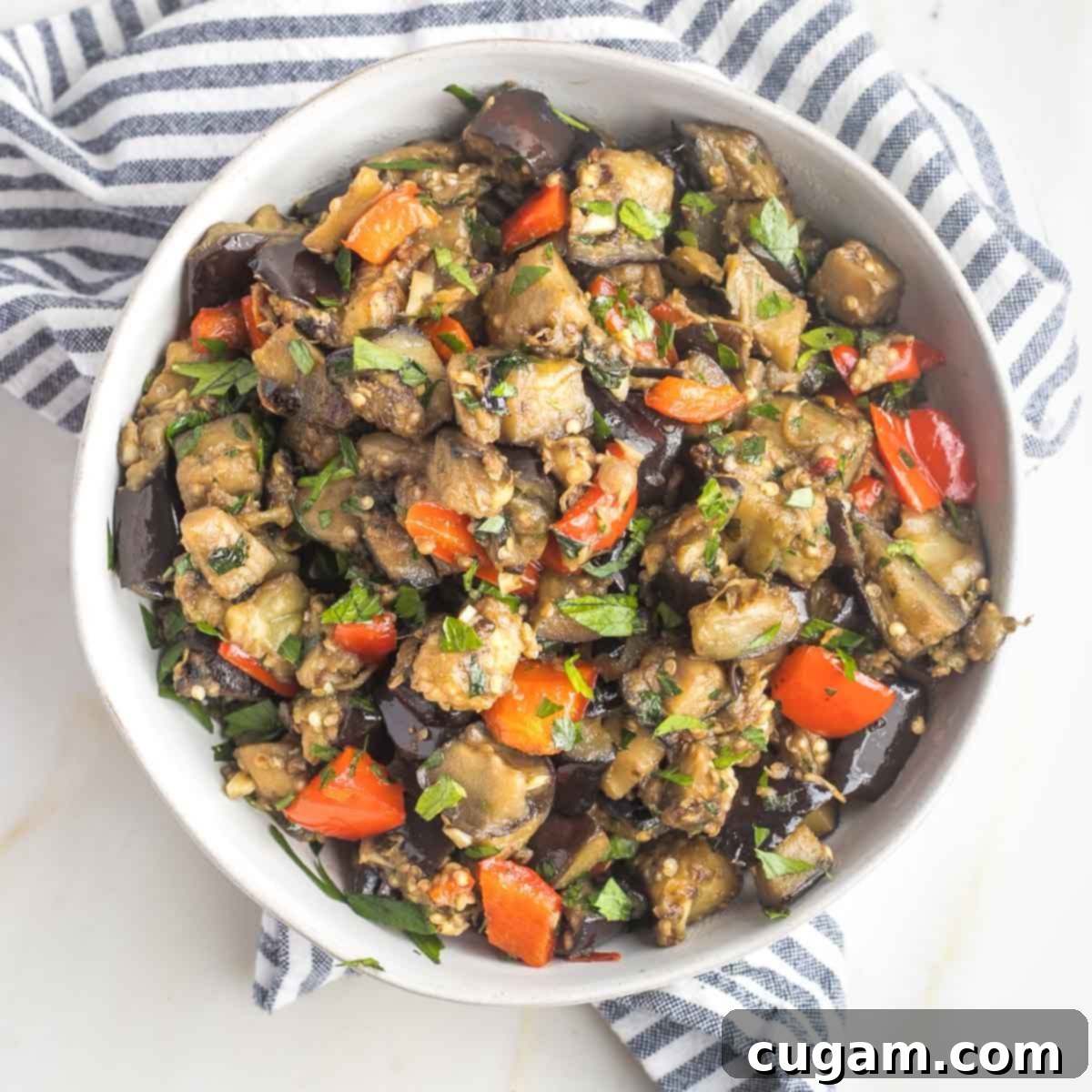Delicious Sautéed Eggplant Salad Recipe: An Easy & Healthy Mediterranean Side Dish
Some of the most cherished recipes are those that celebrate the simplicity of fresh, vibrant ingredients. This **Sautéed Eggplant Salad Recipe** is a perfect example, bringing together the humble eggplant with a symphony of flavors that truly sing. Imagine tender, garlicky eggplant cubes, brightened by sweet red bell peppers and aromatic fresh parsley, all coming together in a harmonious blend that will have you reaching for seconds. This easy **sautéed eggplant recipe** is not only incredibly flavorful but also remarkably quick to prepare, taking just about 20 minutes from start to finish. It’s an ideal candidate for a light and satisfying simple lunch or a fantastic healthy side dish that complements almost any meal.
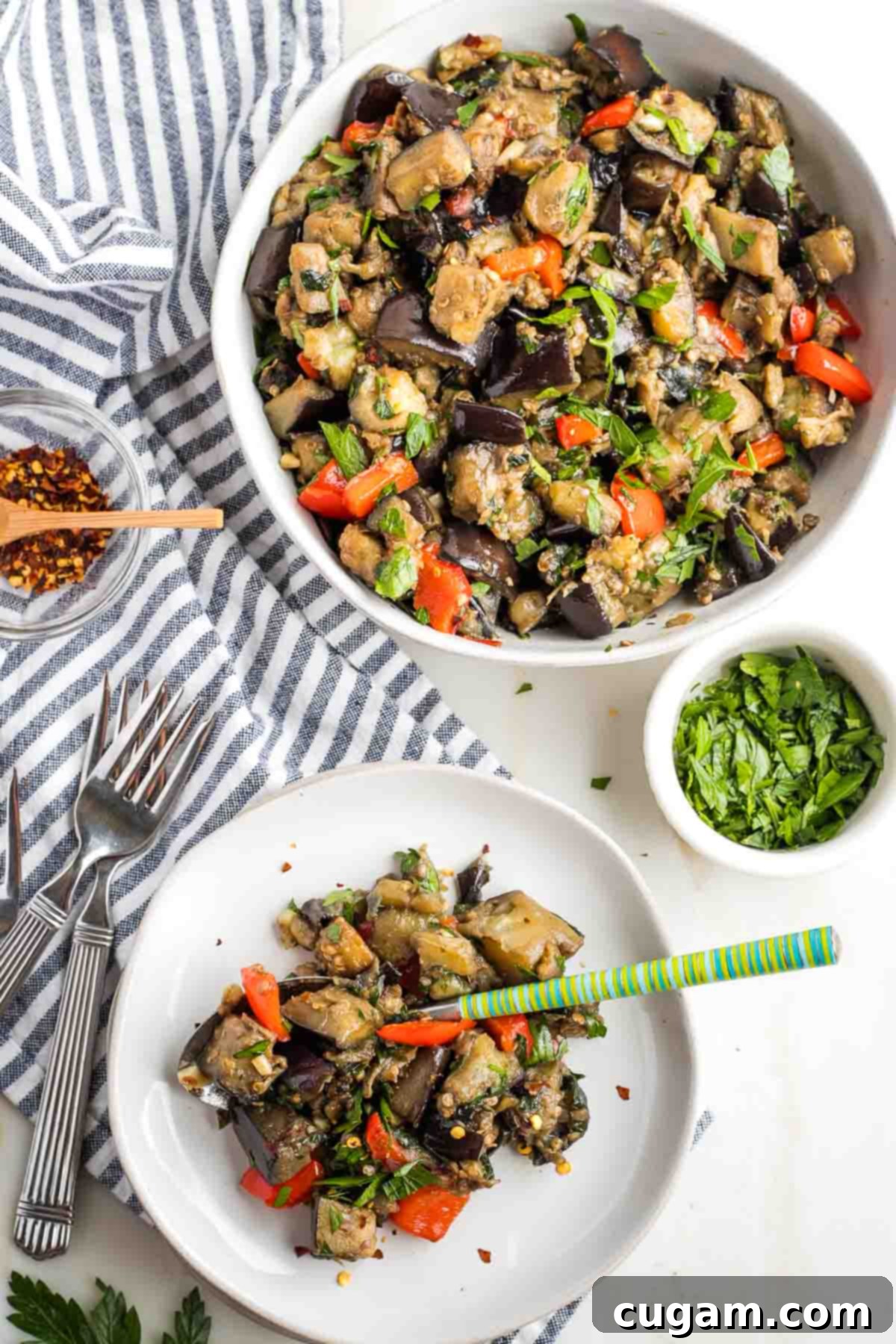
Learning how to cook eggplant on the stovetop becomes incredibly easy with this flavorful recipe. While sautéing is our preferred method here, fresh eggplants are incredibly versatile and can also be roasted or even grilled to create a delicious and healthy side dish that everyone will love. If you find yourself with an abundance of eggplant from your garden or the farmer’s market, don’t fret! Eggplant is a culinary superstar, and there are many delightful ways to enjoy it. Here are a few more easy eggplant recipes to inspire your cooking:
- Mediterranean Roasted Eggplant: This recipe transforms simple eggplant slices and fresh herbs into a wholesome side dish with minimal oil, perfect for a lighter meal.
- Grilled Ratatouille Salad: One of my absolute favorite ways to utilize fresh summer vegetables, this dish offers all the classic flavors of ratatouille without heating up your kitchen. It’s a brilliant choice for warm weather.
- Baba Ghanoush: Elevate your summer dip repertoire with this smoky, creamy delight. It’s a fantastic combination of sautéed vegetables and whole roasted eggplant, resulting in the best eggplant dip you’ll ever make. Serve it with warm pita bread and crispy baked falafel balls for an unforgettable summer main course or appetizer spread.
Why You’ll Adore This Sautéed Eggplant Salad
This simple sautéed eggplant salad isn’t just a recipe; it’s a testament to how fresh ingredients and minimal effort can create something truly spectacular. Here’s why this dish will quickly become a staple in your kitchen:
- Quick and Easy: In today’s fast-paced world, finding a recipe that goes from prep to plate in just 20 minutes is a treasure. This eggplant salad is ideal for busy weeknights or when you need a delicious meal without spending hours in the kitchen. Its straightforward steps ensure success for even novice cooks.
- One Pan Wonder: Who doesn’t love less cleanup? This recipe primarily uses a single skillet for cooking, significantly reducing the amount of washing up afterwards. It’s a true one-pan wonder that simplifies your cooking experience.
- Simple, Yet Bursting with Flavor: The magic of this dish lies in its ability to highlight the natural goodness of the vegetables. Fresh garlic and earthy cumin are the perfect companions, working in harmony to amplify the inherent sweet and savory notes of the eggplant and red peppers, without overpowering them.
- Healthy Side Dish for Everyone: This vibrant salad is not only delicious but also incredibly nutritious. Packed with fiber, vitamins, and minerals from the fresh vegetables, it makes a wonderfully healthy addition to any meal. It’s naturally vegan, vegetarian, and gluten-free, making it suitable for a wide range of dietary preferences.
Essential Ingredients and Smart Substitutions
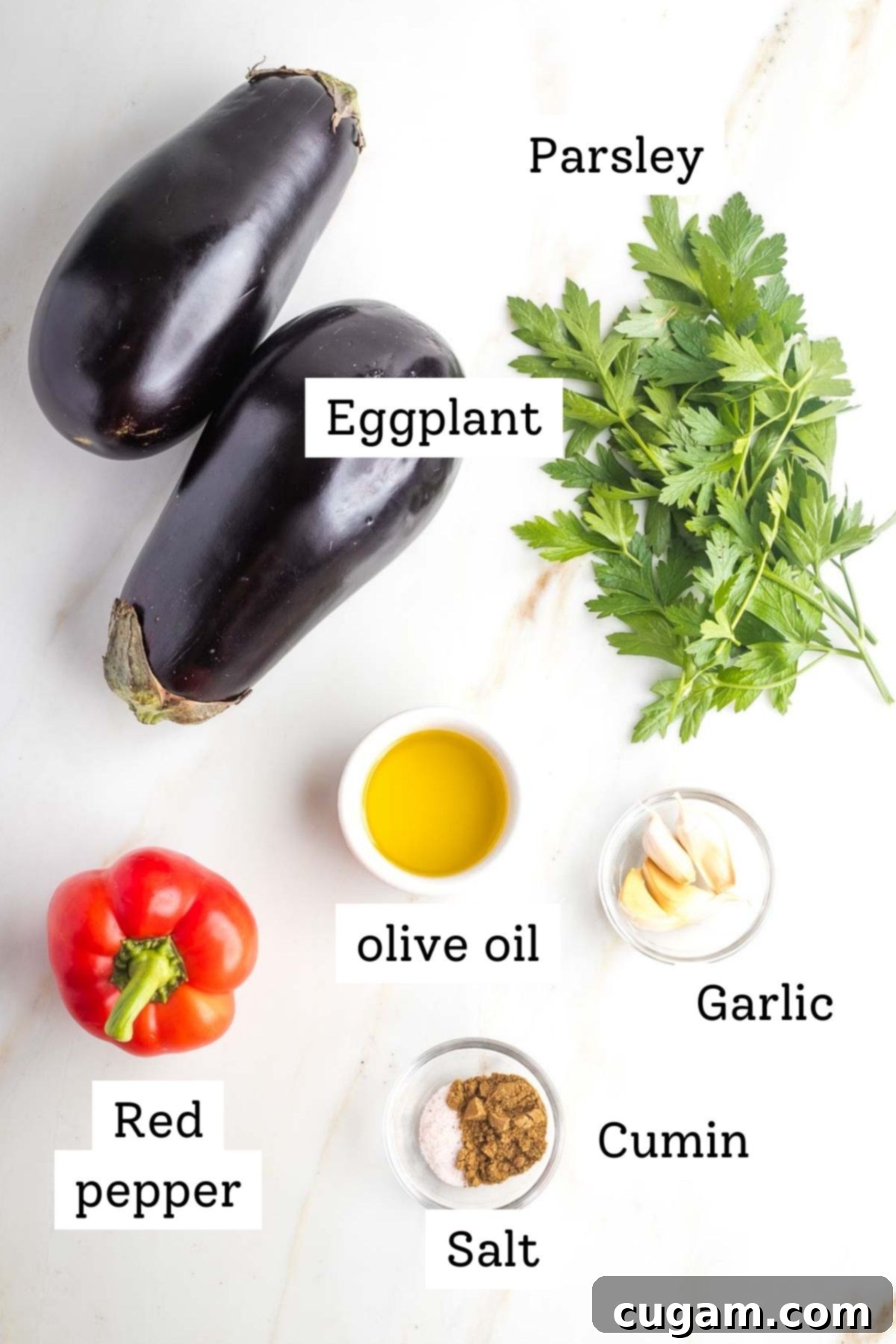
Gathering high-quality ingredients is the first step to a truly outstanding sautéed eggplant salad. Here’s a closer look at what you’ll need and some handy substitutions:
- Eggplant: The star of our show! When selecting eggplant, look for firm, heavy ones with shiny, taut skin. This recipe truly shines with it. Interestingly, this method also works beautifully with zucchini or yellow summer squash if you’re looking for a change or can’t find good eggplant. Just remember, these squashes will cook in about half the time, so adjust accordingly. (See below for more on choosing the best type of eggplant for this recipe).
- Fresh Parsley: I’m a firm believer that you can never have too many fresh herbs, especially in this dish! Parsley adds a bright, herbaceous note that elevates the entire flavor profile. While flat-leaf (Italian) parsley is often preferred for its robust flavor, curly parsley works well too. Feel free to experiment with other fresh herbs like oregano, basil, or thyme for a different aromatic twist – don’t be shy with the quantities!
- Red Pepper: Bell peppers are typically in season around the same time as fresh eggplant, making them a perfect pairing. Red bell peppers offer a lovely sweetness and vibrant color, but any color bell pepper you have on hand will work just fine. You could also consider adding other seasonal vegetables like cherry tomatoes for an extra pop of flavor and acidity.
- Garlic: Fresh garlic is non-negotiable for the most robust and authentic flavor in this recipe. Its pungent aroma mellows and sweetens as it cooks, infusing the eggplant with irresistible depth. In a pinch, you could use garlic powder, but be sure to avoid garlic salt, as it will throw off the seasoning balance of the dish.
- Olive Oil: Extra virgin olive oil is essential for sautéing and adding a rich, fruity flavor. Eggplant is notorious for acting like a sponge and soaking up oil, so it’s best to drizzle it in a bit at a time, in phases, as suggested in the instructions. This technique helps prevent the eggplant from becoming overly greasy while ensuring it cooks evenly and deliciously.
- Spices (Cumin & Salt): Cumin is the secret weapon here, imparting a wonderful, slightly smoky, and earthy flavor that perfectly complements the eggplant. Just a touch of coarse sea salt is crucial for intensifying all the fresh flavors and bringing them into balance. You might also consider a pinch of black pepper or a tiny dash of smoked paprika for extra depth.
Exploring Different Eggplant Varieties
The world of eggplant is surprisingly diverse, with many delicious varieties available. You can often discover unique types at your local farmers’ markets, specialty ethnic grocery stores, or by looking for locally grown produce at your favorite supermarket. Any of the following eggplant varieties will work beautifully in this sautéed eggplant salad recipe, each offering a slightly different texture and cooking time:
- Asian Eggplants: This category refers to several similar but distinct types of eggplant, all generally known for their delicate flavor and tender skin.
- Japanese Eggplant: Characterized by its long, slender shape and deep purple color, Japanese eggplant has a thinner outer skin and fewer seeds than larger varieties. This means it generally cooks very quickly, often needing only half the cooking time suggested in this recipe.
- Chinese Eggplant: Similar to Japanese eggplant, the Chinese variety is typically slender and long with a medium purple skin and creamy white flesh. It boasts even fewer seeds, which results in a less bitter taste compared to the American globe eggplant. Its delicate nature makes it exceptionally well-suited for stir-fries or this sautéed eggplant recipe, also requiring less cooking time.
- Italian Eggplants: These are quite similar to the classic American Globe Eggplant but tend to be smaller and possess a more tender flesh. Their moderate size makes them easy to handle and cook.
- White Eggplant: Often considered the “original” eggplants, many white varieties available today are heirloom. While their outer skin is a striking white, their interior looks much like traditional purple-skinned eggplants. They can be used interchangeably in nearly all the same recipes, offering a mild flavor.
- Globe Eggplants (American Eggplant): Also known simply as American eggplants, these are the most common variety found in many Western supermarkets. They are large, plump, and dark purple. Globe eggplants are known for holding their shape well during cooking and have a meatier texture. They are excellent for roasting in slices, deep-frying, air frying, or sautéing until they achieve a soft, buttery consistency. For this recipe, if using globe eggplants, ensure they are cut into small, uniform cubes for even cooking.
Mastering the Art of Cubing Eggplant
Consistent knife work is key to ensuring your eggplant cooks evenly and perfectly tender. Here’s a simple step-by-step guide to cutting your eggplant into uniform ½-inch cubes:
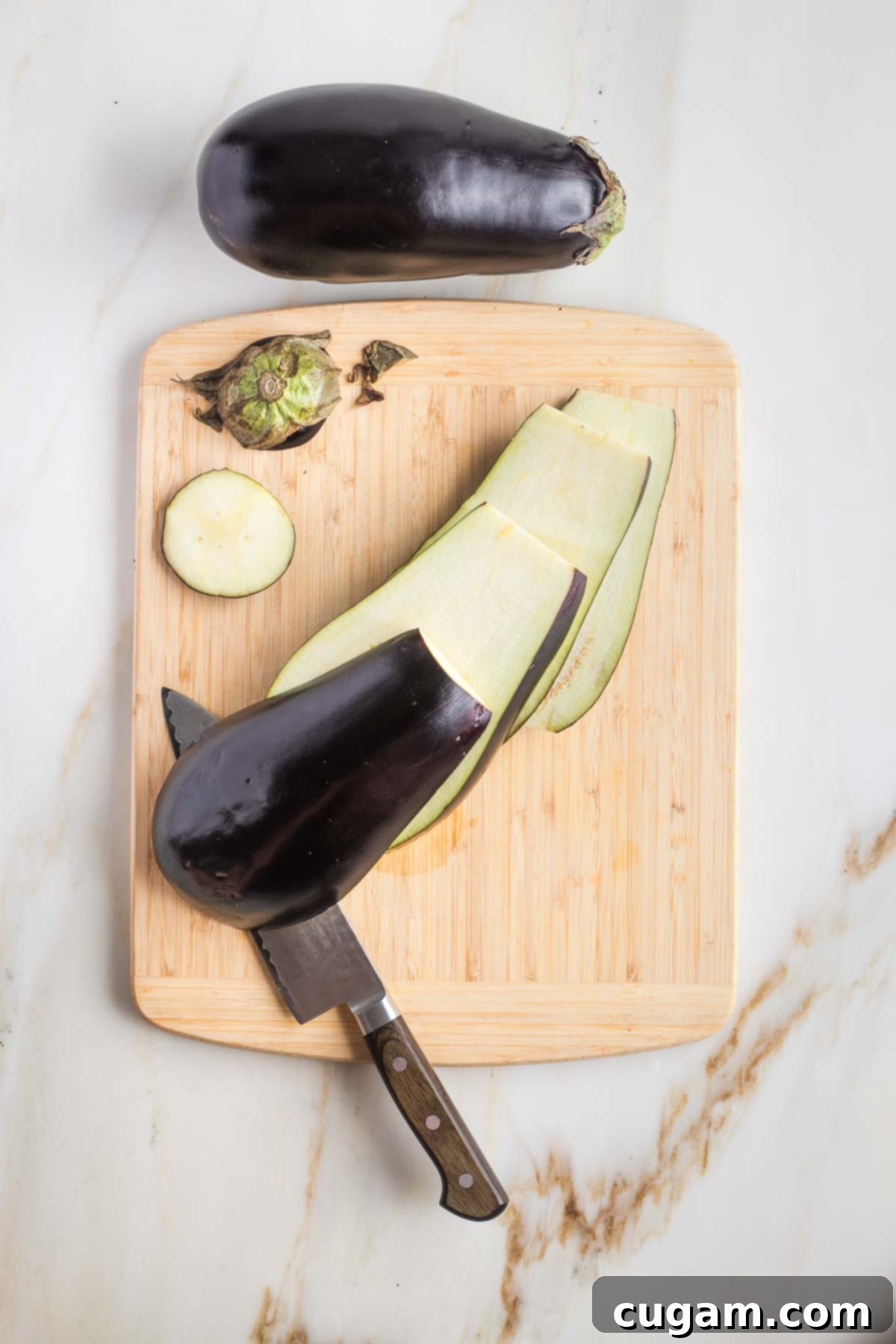
Begin by carefully cutting off both the top (stem end) and the bottom (tail) of the eggplant. This provides a stable base. Place the eggplant cut-side down on your cutting board, then make ½-inch vertical cuts all the way through, creating thick slices.
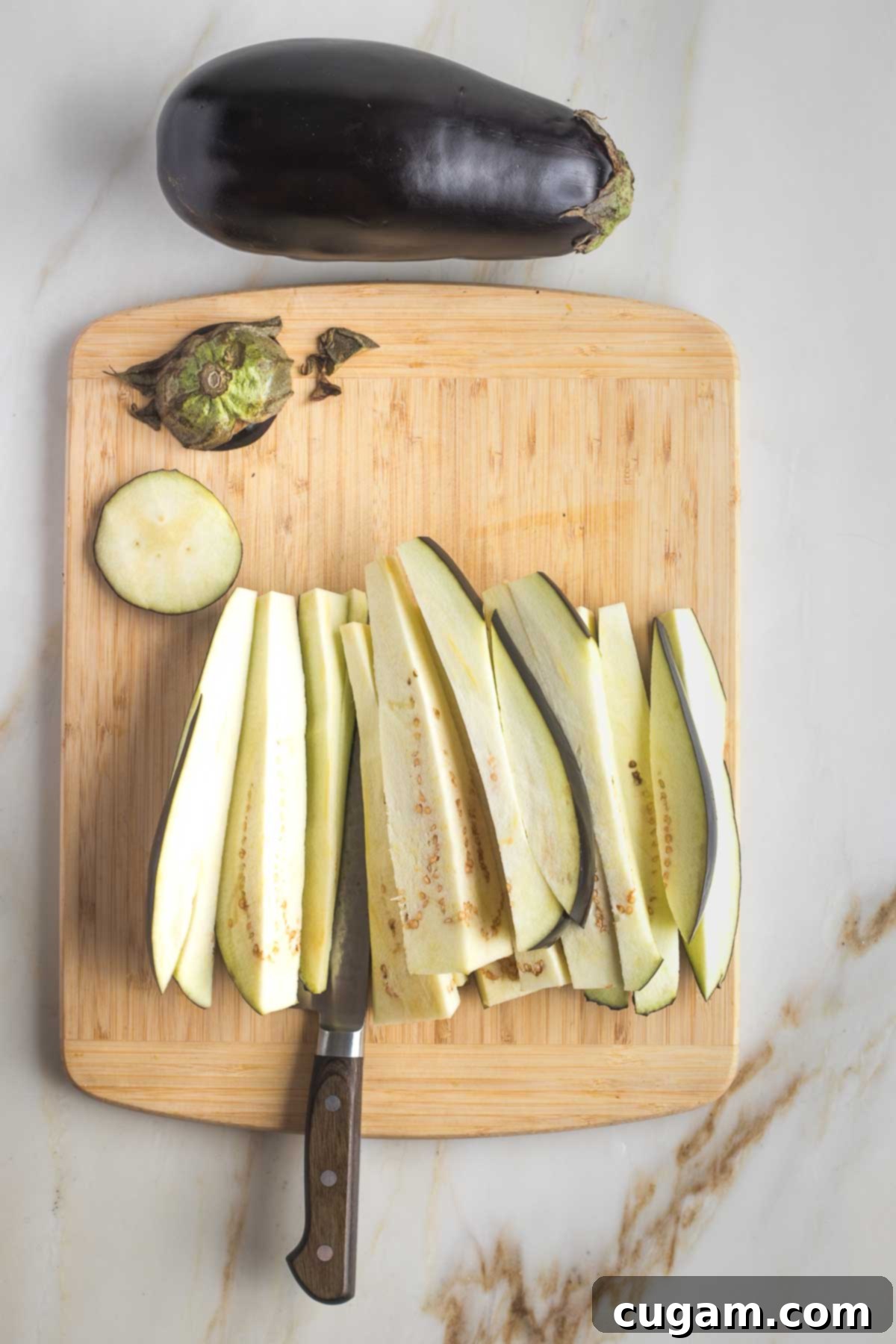
Next, take each thick slice and lay it flat on the cutting board. Cut these slices into long, vertical strips, ensuring each strip is also about ½-inch thick. Aim for uniformity to guarantee even cooking.
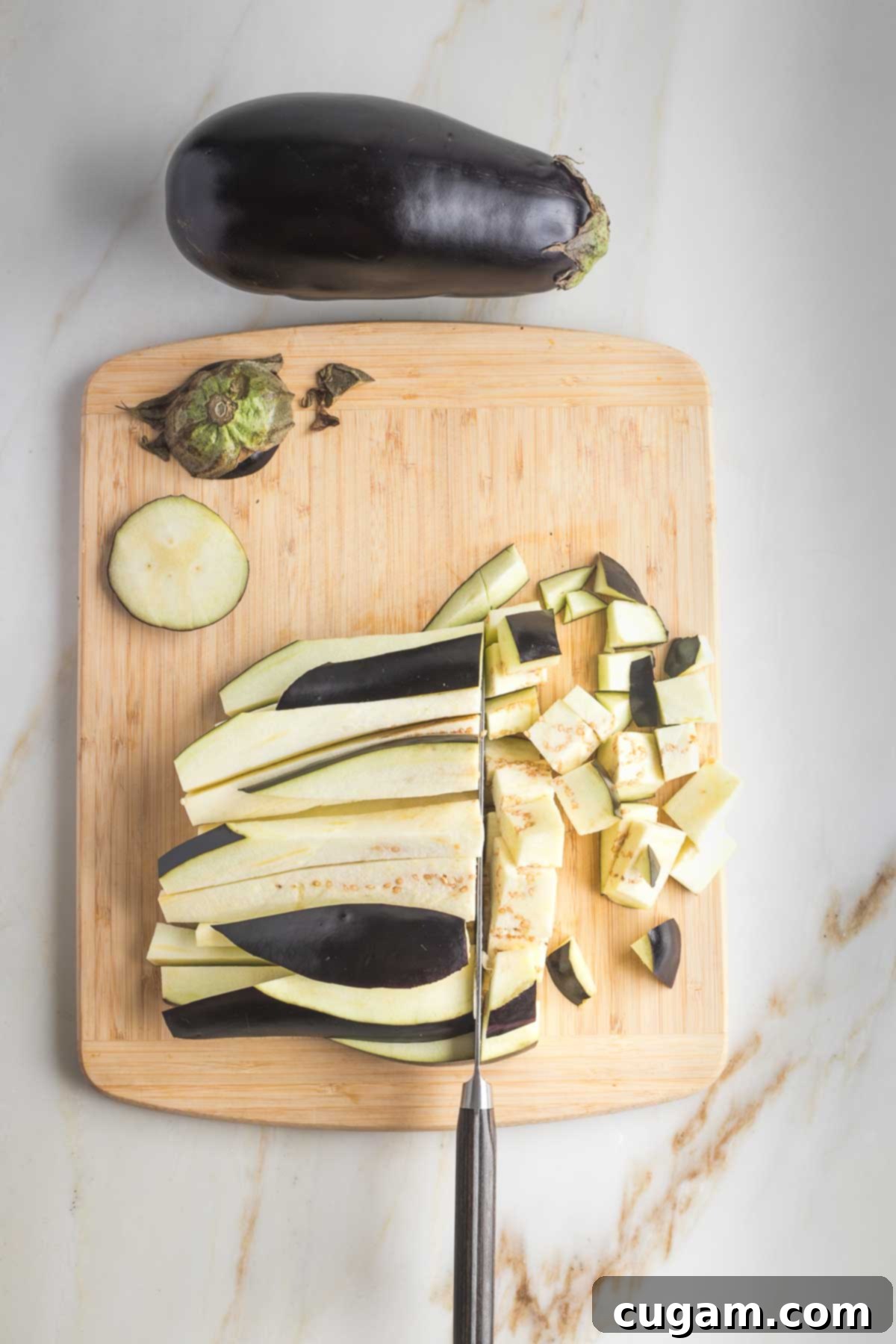
Finally, gather a few strips together and cut across them, creating perfectly formed ½-inch cubes. This method ensures that each piece is roughly the same size, allowing them to cook at the same rate.
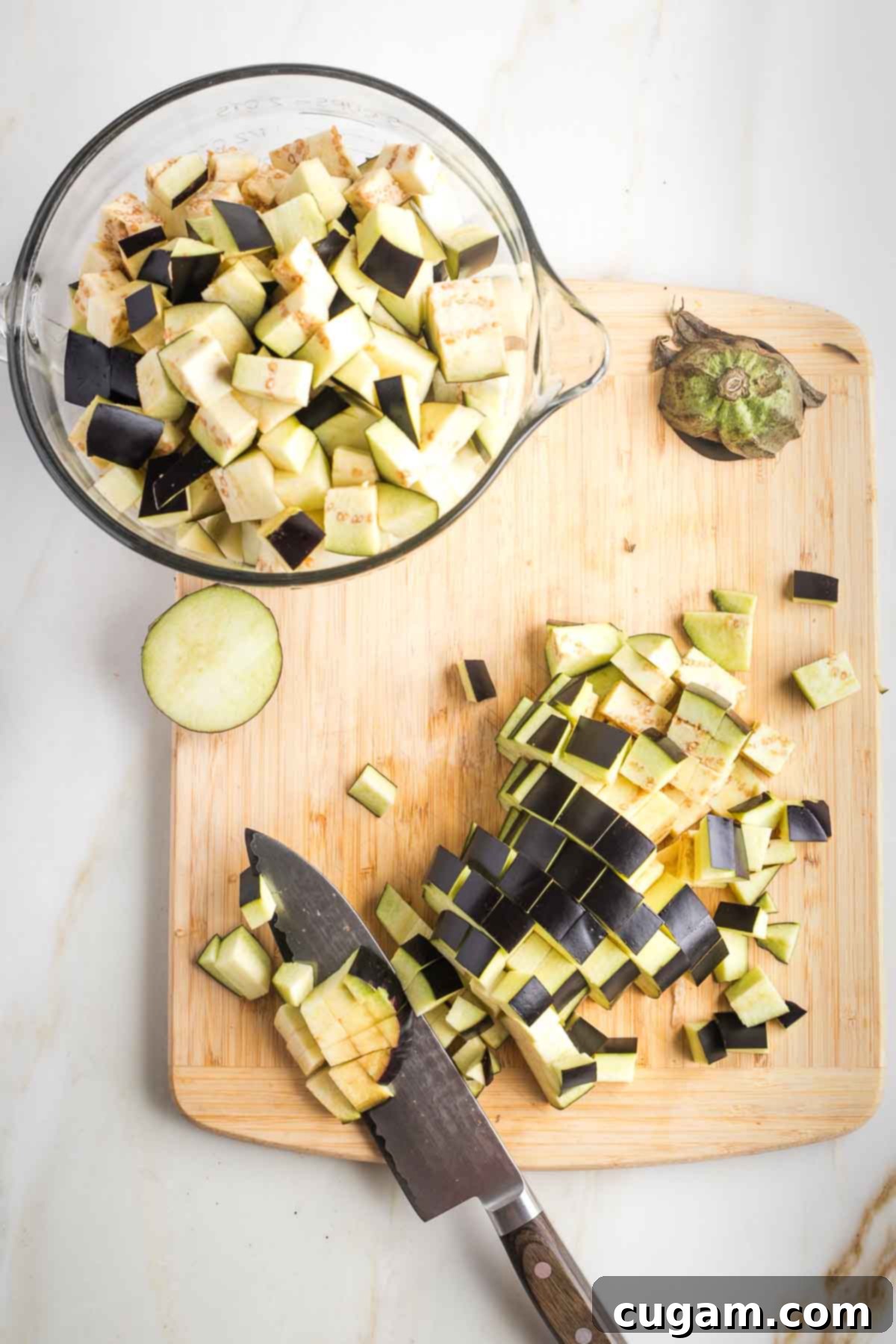
Repeat this cubing process with the second eggplant. By the time you’re finished, you should have approximately 8 cups of beautifully cubed eggplant, ready for sautéing.
Preparing Your Ingredients for the Sautéed Eggplant Salad
This sautéed eggplant salad comes together quickly on the stovetop, making efficient ingredient preparation (mise en place) essential. Having all your vegetables prepped and ready before you begin cooking will ensure a smooth and enjoyable process.
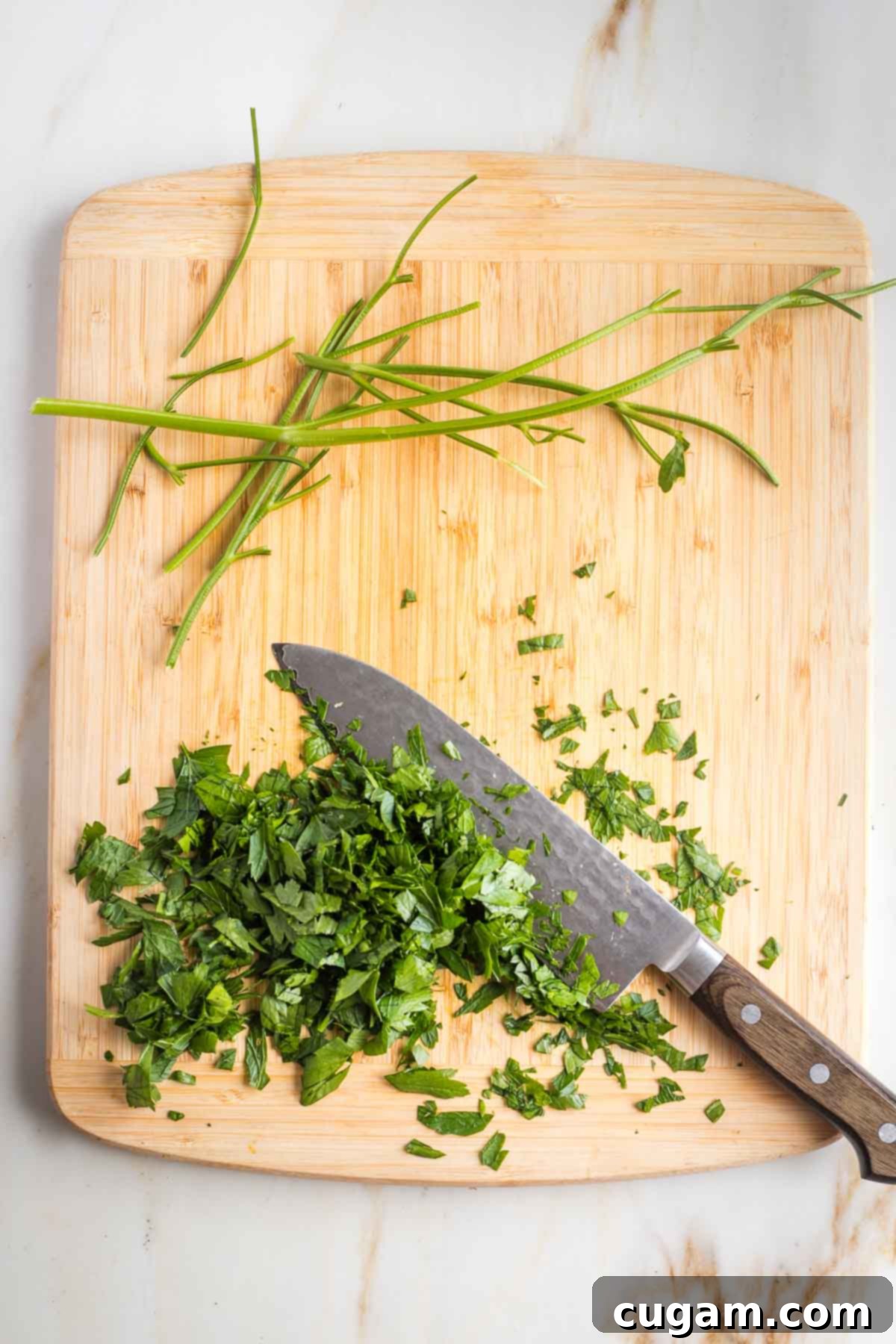
Start by preparing your fresh parsley. Separate the vibrant green leaves from their tougher stems, then gather the leaves and roughly chop them. A finer chop will integrate the flavor more smoothly, while a coarser chop offers more textural contrast. Set the chopped parsley aside, as it will be added in stages.
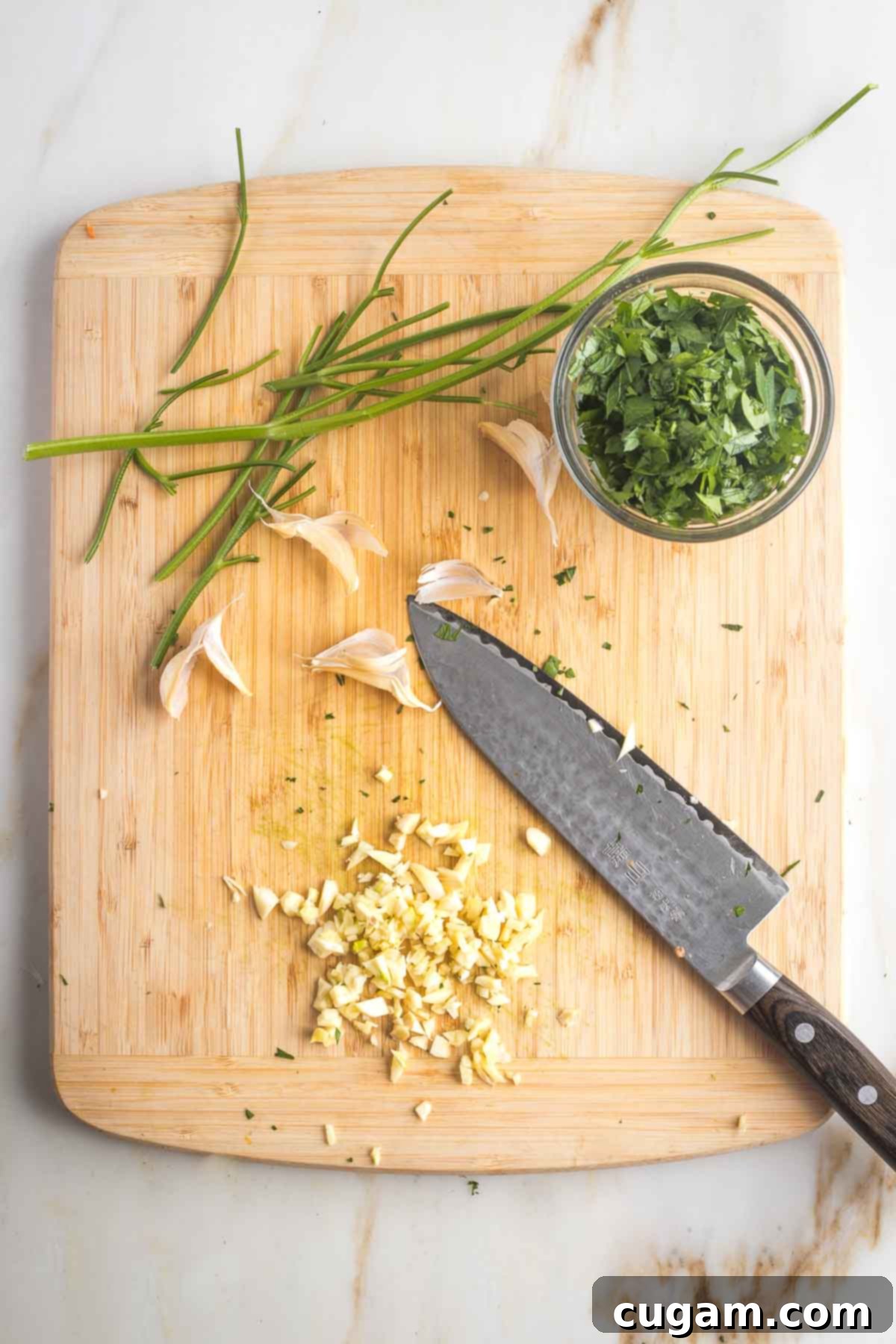
For the garlic, place the cloves on your cutting board and use the flat side of a chef’s knife to smash them with a firm press. This technique makes peeling off the papery skins incredibly easy. Once peeled, roughly chop the garlic. You want enough surface area for its flavor to release, but not so fine that it burns too quickly. Keep the chopped garlic separate from the parsley for now.
The Secret to Perfectly Sautéed Eggplant: Oil in Phases
Sautéing eggplant can sometimes be tricky because it acts like a sponge, eagerly soaking up any liquid, especially oil. This tendency can lead to either dry, rubbery eggplant if too little oil is used initially, or overly greasy eggplant if too much is added at once. My preferred method, and a true game-changer, is to drizzle the olive oil in phases. This ensures the eggplant cooks to a beautiful tender consistency without becoming saturated. Using a well-seasoned cast iron skillet is also highly recommended, as it provides excellent heat retention and a naturally non-stick surface, further aiding in even cooking and delicious browning.
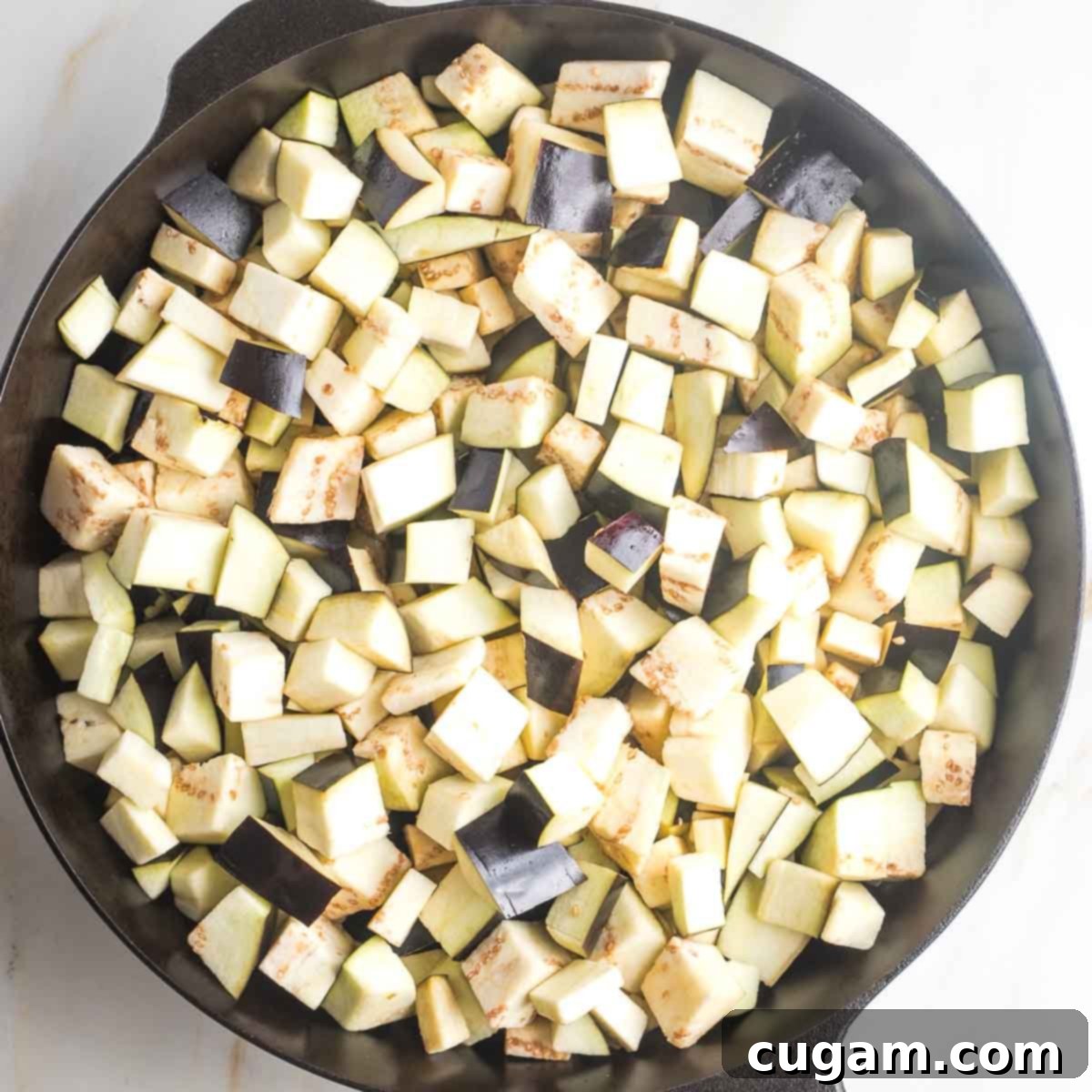
Begin by placing your cast iron or another heavy-bottomed skillet over medium-high heat. Allow it to preheat properly for a minute or two. Swirl in 2 tablespoons of the olive oil, ensuring the bottom of the pan is lightly coated. Add all the cubed eggplant to the hot pan. Initially, the pan will seem very full, but don’t worry – eggplant shrinks significantly as it cooks. Sauté for 3-4 minutes, stirring occasionally to ensure even cooking and to prevent sticking. You’ll notice the eggplant beginning to soften and slightly brown.
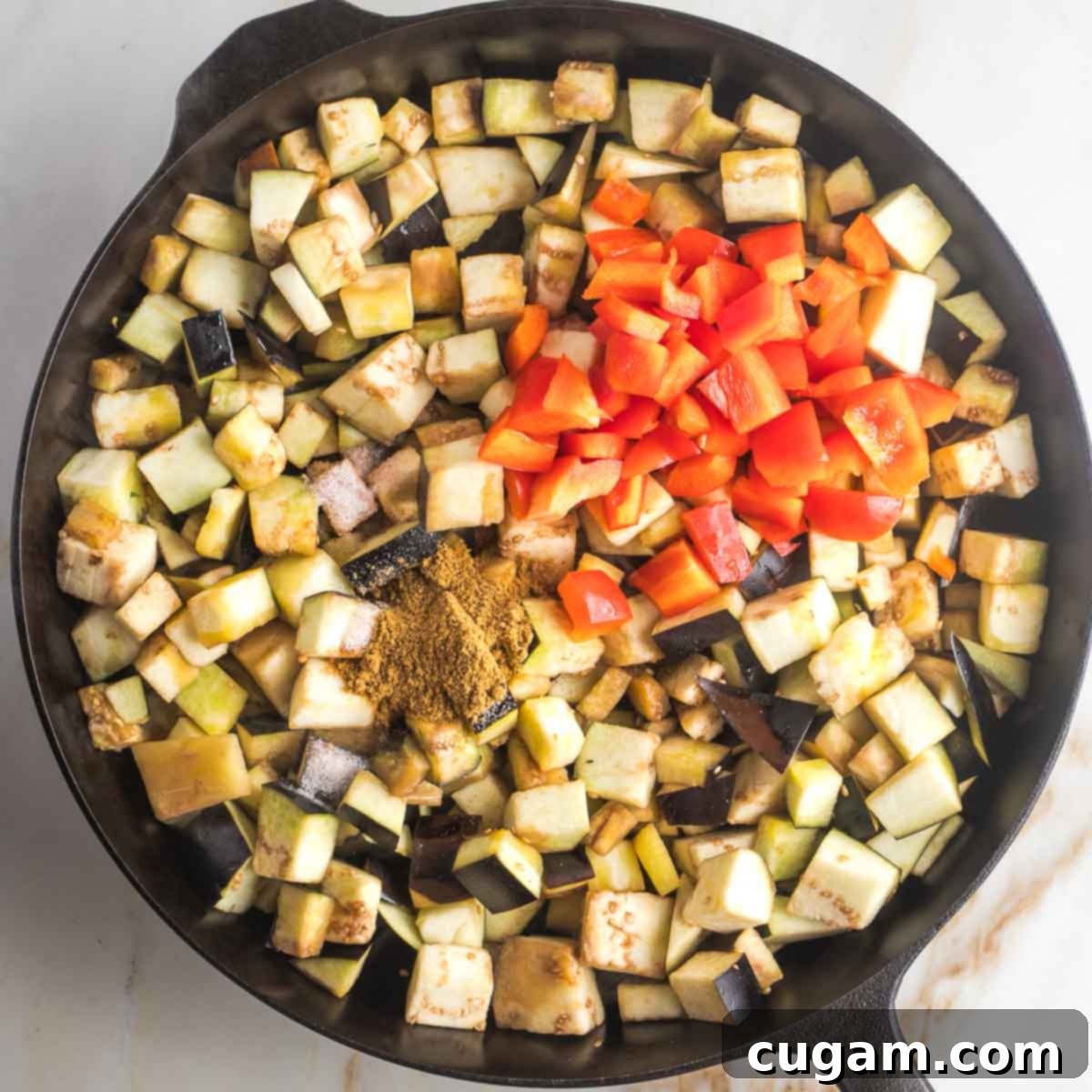
Now it’s time to introduce the other vibrant flavors. Add the diced red peppers to the pan, along with the cumin and salt. Drizzle in the remaining tablespoon of olive oil. Stir everything together thoroughly, making sure the spices are evenly distributed and the oil coats the vegetables. Continue to cook, stirring frequently, until the eggplant and red peppers are tender and the eggplant has significantly shrunk to about one-third of its original volume. This usually takes another 6-8 minutes. Keep scraping any bits from the bottom of the pan with your spatula to prevent burning and ensure maximum flavor.
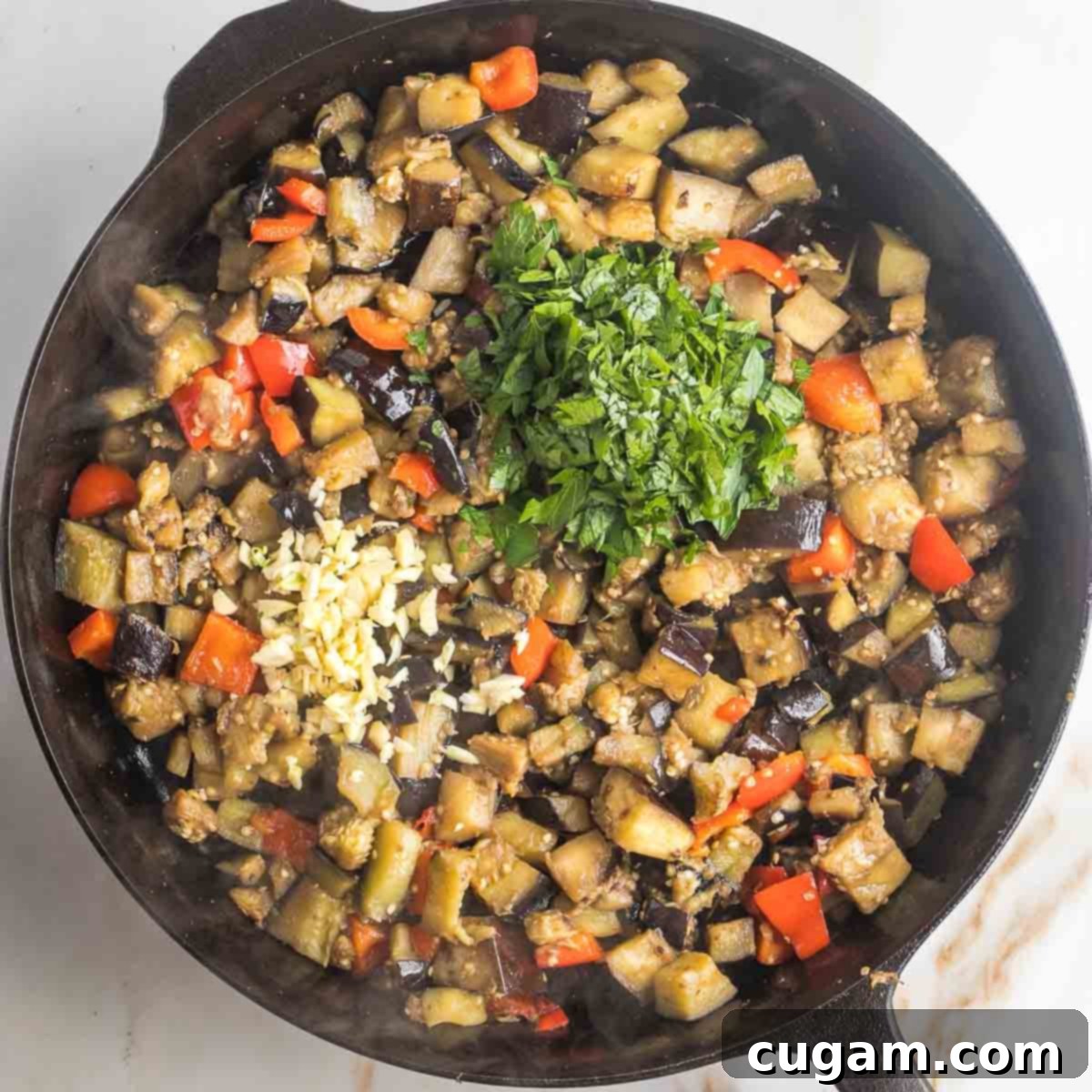
Once the eggplant is tender, sprinkle in a quarter cup of the chopped parsley along with all of the minced garlic. Stir this into the mixture and cook for another 2-3 minutes, just until the garlic becomes wonderfully fragrant. Be careful not to let the garlic brown or burn, as this can turn bitter. Give the mixture another good stir to ensure any larger pieces of eggplant have become fully tender.
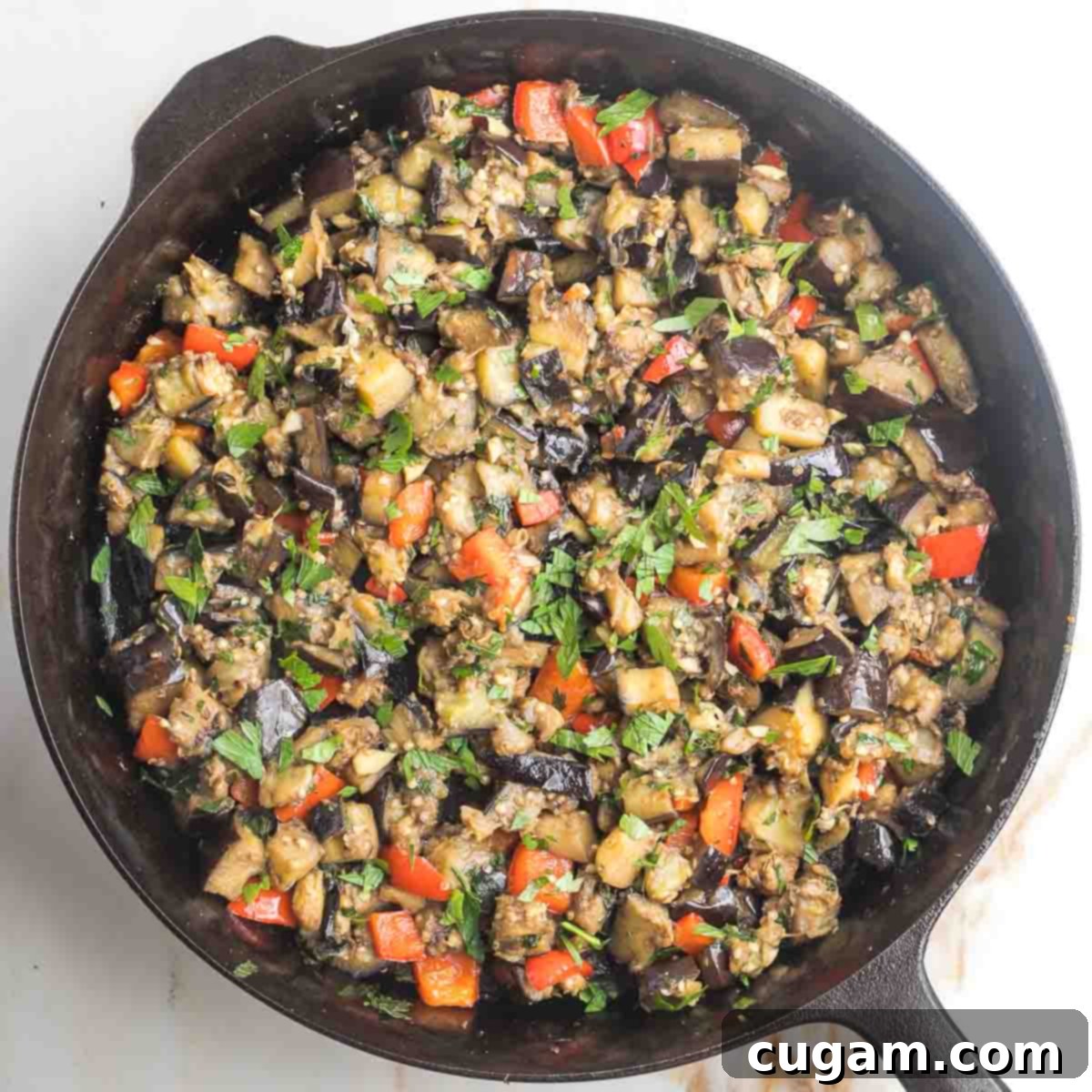
Turn off the heat. Sprinkle in the remaining quarter cup of fresh parsley and mix everything well. The residual heat from the skillet will gently wilt the parsley, releasing its fresh aroma. Taste for seasoning and adjust with more salt if needed. If you enjoy a touch of heat, now is the perfect time to add a pinch of red pepper flakes. Transfer your delicious sautéed eggplant salad to a serving dish and serve it warm or at room temperature. It’s incredibly versatile and tastes great either way!
Creative Variations to Elevate Your Eggplant Salad
While this sautéed eggplant salad recipe is truly perfection in its simplest form – period, end of story – there’s always room to explore and personalize. If you’re feeling adventurous or want to tailor it to your taste buds, here are some fantastic embellishments you can try:
- A Mediterranean Touch with Olives and Capers: One of my personal favorite additions is finely chopped **olives** (like Kalamata or Castelvetrano) and/or briny **capers**. They introduce a wonderful salty, tangy complexity that gives off a distinct Mediterranean eggplant salad vibe. My husband isn’t a fan of these, so I often omit them when cooking for us, but I highly recommend trying it if you love those flavors!
- Adding Crunch and Protein with Nuts and Seeds: Incorporating any type of nut or seed is a brilliant way to add a delightful crunch and a boost of protein. Toasted pine nuts and chopped almonds are my favorites for their subtle flavor and satisfying texture. Sesame seeds also work wonderfully, though they tend to lend a more distinct Asian flavor profile to the dish, which can be a delicious twist in itself.
- Brightening with Acidic Components: A touch of acidity can truly balance and brighten the rich flavors of the eggplant. Freshly diced **tomatoes**, especially sweet cherry tomatoes cut in half, add a lovely juicy and acidic component. Alternatively, you can achieve that refreshing touch of acid with a generous splash of high-quality **balsamic vinegar** or a squeeze of fresh **lemon juice** right before serving.
- Spicy Sautéed Eggplant: If you crave a bit of heat, it’s incredibly easy to spice up these sautéed vegetables. Simply add a sprinkle of red pepper flakes to the pan at the same time you add the cumin. Adjust the quantity to your preferred level of spiciness for a fiery kick.
Creative Ways to Serve This Versatile Eggplant Dish
The beauty of this sautéed eggplant salad lies in its incredible versatility. It can effortlessly adapt to various roles on your dining table, from a light standalone dish to a flavorful component of a larger meal.
- As a Standalone Salad: Serve it simply as a refreshing salad. It’s equally delicious served cold, allowing the flavors to meld and deepen, or at room temperature, which highlights the tenderness of the eggplant.
- A Perfect Side Dish: This vibrant dish makes an excellent accompaniment to a wide range of main courses. It pairs wonderfully with protein-rich options like tofu satay, grilled chicken, or hearty baked falafel. Its light and fresh profile provides a delightful contrast to richer entrees.
- As a Dip or Spread: Don’t limit yourself to just a salad! This sautéed eggplant has a delightful texture that makes it perfect for spooning on top of a quick and easy flatbread. You can also slather generous spoonfuls onto slices of crusty bread and serve it as a rustic eggplant bruschetta. For entertaining, add it to a crudités board alongside your favorite crackers and fresh vegetables for a flavorful and healthy dip option.
Storing Your Sautéed Eggplant Salad for Later Enjoyment
Proper storage ensures you can savor the delicious flavors of this eggplant salad for days to come.
- Refrigeration: Any leftovers should be stored in an airtight container in the refrigerator. It will maintain its freshness and flavor for up to 5 days, making it perfect for meal prepping.
- Reheating: If you prefer it warm, gently reheat the salad in a 300-degree Fahrenheit oven for about 10 minutes, or simply warm it on the stovetop over medium-low heat until it’s heated through. Be careful not to overheat, as this can diminish its tender texture.
- Enjoying Cold or Room Temperature: One of the many charms of this recipe is that leftovers are just as delicious eaten cold or at room temperature, straight from the fridge. This makes it an excellent option for packed lunches or quick snacks.
- Freezing Not Recommended: Unfortunately, freezing eggplant tends to change its delicate texture, making it mushy upon thawing. For the best quality and enjoyment, I do not recommend freezing this sautéed eggplant salad.
Debra’s Pro Tips for the Best Sautéed Eggplant Salad
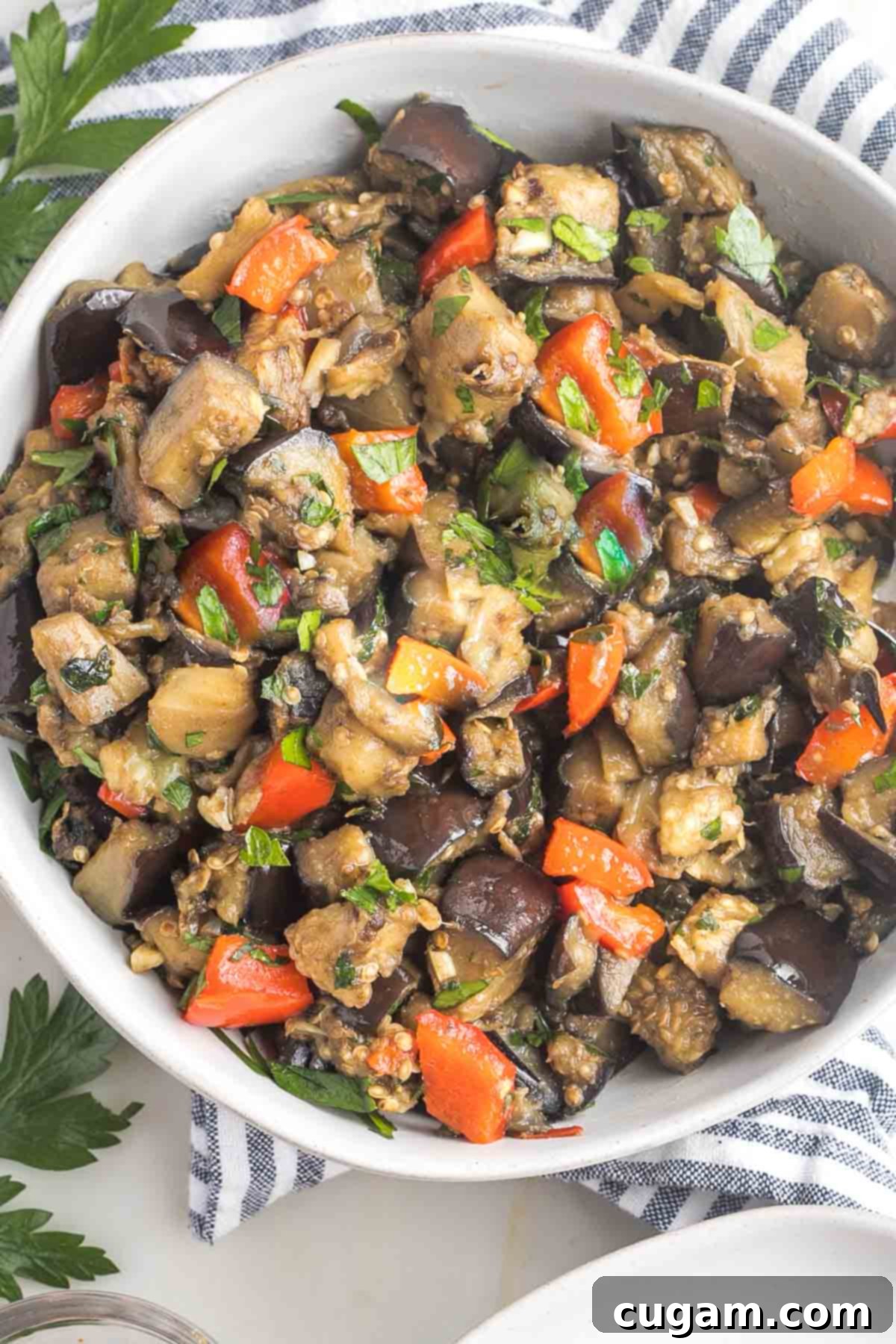
Achieving perfectly tender and flavorful sautéed eggplant is simple with these expert tips:
- Adjust for Eggplant Size: This recipe is calibrated for two medium-large eggplants, yielding roughly 8 cups of cubed eggplant. If your eggplants are particularly large and produce significantly more than this amount, you will likely need to adjust the other ingredients slightly, adding a bit more olive oil, cumin, and salt to ensure a balanced flavor and proper cooking.
- Choose Your Largest Frying Pan: While eggplant shrinks considerably as it cooks, it takes up a lot of space in the pan at the beginning. Using your largest frying pan or skillet will provide ample surface area, allowing the eggplant to spread out and sauté rather than steam. This promotes better browning and a more tender texture.
- Avoid Adding Water to the Pan: It might be tempting to add water if the pan seems dry, but resist the urge! Eggplant is highly absorbent, and adding water will cause it to soak up the liquid and become unpleasantly rubbery. Instead, as suggested above, add the olive oil in phases and stir frequently. This technique ensures that the eggplant cubes remain moist and tender without sticking to the bottom of the pan, achieving that desired sautéed texture.
Did you know commenting and rating recipes is one of the best ways to support your favorite food bloggers? If you made this recipe, please consider leaving a five-star rating below and a comment sharing your experience. Also, we’d love to see your creations! Please share your photos on Instagram by tagging me @dkhealthcoach and using the hashtag #debraklein!
📖 Recipe
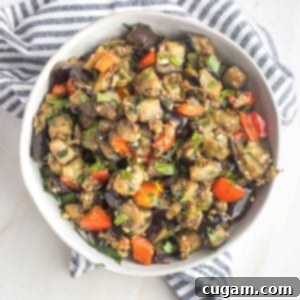
Sauteed Eggplant Salad
Rate this Recipe
Pin Recipe
Equipment
-
Cast iron skillet
-
Chef’s knife
-
Extra Large Bamboo Cutting Board
-
Spatula
Ingredients
- 2 medium-large eggplants about 8 cups cubed
- 1 red bell pepper
- 3 tablespoon extra virgin olive oil
- 1 ½ teaspoon cumin
- ½ teaspoon coarse sea salt
- 3 cloves garlic
- ½ cup fresh parsley finely chopped and divided
Instructions
-
Finely chop parsley. Smash garlic cloves and then roughly chop. Set aside prepped garlic and parsley.
-
Cut off root end and bottom of eggplant. Set flat on a cutting board on the bottom cut side. Make ½” slices through the top. Lay them flat and cut into ½” strips and then across to make ½” cubes.
-
Set heavy skillet over medium heat and swirl in 1 tablespoon of the olive oil. Toss in the eggplant cubes, then drizzle on another 1 tablespoon oil. Cook for 3-4 minutes, stirring a couple of times. The pan will seem super full. It’s ok and temporary, as the eggplant will shrink as it cooks.
-
Meanwhile, dice the red pepper. Add to the pan with the eggplant along with cumin and salt and drizzle the remaining tablespoon olive oil into the pan.
-
Cook, stirring frequently to prevent eggplant from sticking to the bottom. Use a heavy spatula to scrape any bits off as you cook.
-
When eggplant is tender (about 6-8 minutes), sprinkle on ¼ cup of the parsley and all of the garlic. Stir and cook for about 2 minutes, until garlic is fragrant.
-
Turn off heat and stir in remaining ¼ cup parsley. Taste for seasoning and add a pinch of red pepper flakes if desired. Transfer to a serving dish and enjoy warm or at room temperature.
Notes
Nutrition
Note
The nutrition calculations were done using online tools. To obtain the most accurate representation of the nutritional information in any given recipe, you should calculate the nutritional information with the actual ingredients you used. You are ultimately responsible for ensuring that any nutritional information is accurate, complete and useful.
